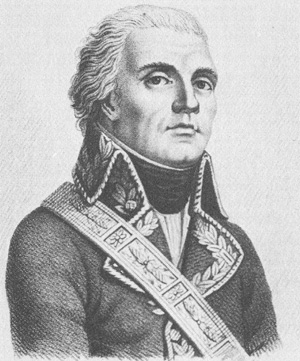General Jacques Christophe Coquille Dugommier

Born: August 1, 1738
Place of Birth: Trois-Rivières, Guadeloupe, France
Died: November 17, 1794
Cause of Death: Killed in action
Place of Death: Montagne Noire, France
Arc de Triomphe: DUGOMMIER on the west pillar
Pronunciation:
The son of an attorney general of Guadeloupe, Jacques Christophe Coquille was later more commonly known by the name of Dugommier. He initially joined the military in 1753 when he entered a company of gentlemen cadets of the colonies at Rochefort. After serving for a period of time with the naval batteries of La Rochelle and the isle of Ré, during the Seven Years War he helped defend Guadeloupe from the British in 1759 and then in 1762 he helped defend Martinique from the British. Afterwards, he returned to France. A few years later Dugommier returned to Guadeloupe where he remained for some time. In 1778 he raised and equipped a unit of fifty volunteers and he joined d'Estaing's expedition to take Saint Lucia during the American Revolutionary War. The expedition ultimately failed but Dugommier distinguished himself and two years later he was recognized as a Knight of Saint Louis. In 1782 he left military service.
In 1789, as the French Revolution was getting underway in France, back in Guadeloupe Dugommier was selected as a member of the National Assembly convening locally. In March of 1790 he traveled to Martinique to help the inhabitants of Saint-Pierre who were revolting against the local garrison. Dugommier reestablished the peace and then embarked for Guadeloupe. However, later that year he went with the governor of Guadeloupe to support the patriots in Martinique against the aristocratic planters supported by the Martinique authorities. He led 300 men on this expedition but they were defeated in combat and returned to Guadeloupe.
In 1791 Dugommier was sent to Paris as the representative of the Windward Isles to meet with the Legislative Assembly. The next year he asked to return to military service and this request was granted with Dugommier being given the rank of maréchal de camp. Initially Dugommier joined the Army of Italy in 1793 and he defeated the Austrian and Sardinian forces at Gilette and Utelle that October. The next month he was promoted to général de division and placed in charge of the army to retake Toulon. Leading from the front, Dugommier was wounded by two blows to the right arm and shoulder while repulsing a sortie. Following the intelligent advice and plan of his artillery commander Captain Napoleon Bonaparte, his forces took the city before long.
In the meantime Dugommier was made the first of four representatives of Martinique in the National Convention. His next assignment was as commander-in-chief of the Army of the Eastern Pyrenees, which he assumed command of in January of 1794. More capable than his predecessors, in late April Dugommier defeated the Spanish general La Union at Monts Albères and a few days later his men took the camp at Boulou. Later in May he was wounded in the night attack on Fort Saint-Elme but his forces successfully took Collioure. That August Dugommier was again victorious, this time at Saint-Laurent de la Mouga, and then in September his men took Fort Bellegarde. In November, as the Battle of Montagne Noire was just about to get underway, an artillery shell landed next to him as he ate breakfast, killing him.1
Notes
- Margaret Chrisawn, The Emperor's Friend: Marshal Jean Lannes, (Westport: Greenwood Press, 2001), 10.
Bibliography
- Divry, Arnauld. Les Noms Gravés sur l'Arc de Triomphe. Paris: L'Harmattan, 2017.
- Six, Georges. Dictionnaire Biographique des Généraux & Amiraux Français de la Révolution et de l'Empire (1792-1814). 2 vols. Paris: Gaston Saffroy, 2003.
Updated August 2024
© Nathan D. Jensen